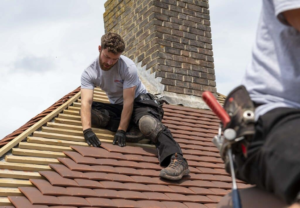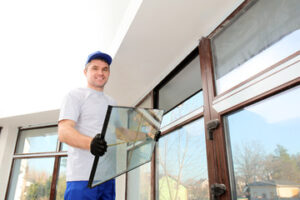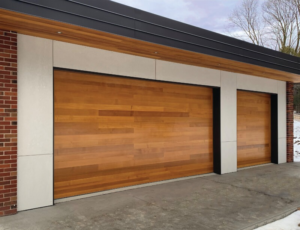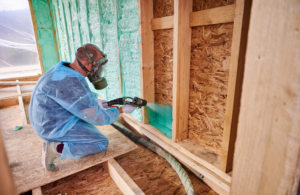The roof is one of the most crucial components of a home. It shields against harsh weather and significantly impacts the property’s energy efficiency and aesthetic appeal. Click Here to learn more.
Roofing requires copious amounts of willpower and patience. Roofers work year round in torrid heat and icy cold to complete their tasks.

Roof terms you will encounter include rakes, eaves, valleys, and ridges. Roofing also involves roof decking or sheathing and an underlayment.
Plywood
Plywood is used as a base for most roofing materials. It provides a layer of sheathing that supports the weight of the roof’s covering, and it also helps protect against weather elements and prolongs the life of the roofing materials.
Plywood consists of thin layers, or “plies,” of wood veneer that have been bonded together using an adhesive. It is an engineered wood from the family of manufactured boards, which includes medium-density fiberboard (MDF), oriented strand board (OSB), and particle board (or chipboard).
The first step in making plywood is to fell the trees. This is done using a high powered chain saw or hydraulic shears. The tree trunks are then dragged to a loading area for transport to the plywood mills. Once at the mills, the logs are reduced to small blocks by using a planer. The smaller blocks are then cut into long ribbons, called veneers. These are then conditioned, soaked, and sorted for appearance and defects. The best veneers are then glued together into long sheets, known as ply boards.
Different types of plywood are produced based on their intended use. For example, if the plywood will be exposed to moisture, then it must be made from a special type of wood. This is usually referred to as marine grade plywood. All other types of plywood are referred to as general purpose.
Once the ply boards are prepared for their intended use, they can be sliced into sheets or curved into curves depending on the intended shape. Each layer of the ply boards has its grain set with typically alternate direction between each layer. This is called cross-graining and helps reduce the tendency of the plywood to split when nailed and also prevents shrinkage or expansion.
There are many different grades of plywood available, and the type that is used in roofing depends on the structural strength that is required. For example, there is CDX plywood which is a durable plywood designed for construction purposes and can handle moisture during the build process.
The thickness of the plywood also varies depending on the load that will be placed on the roof structure. For example, 3/8″ plywood is commonly used in shingle roofs and can support moderate loads. While 1/2″ plywood is more common for traditional roofs and can withstand heavier loads.
Fascia
The fascia is a key part of your roofline, connecting the soffit to the gutter system and helping to prevent water damage to the shingles. It also helps add a polished look to your home. Unlike the soffit, which is often concealed by the gutters, your fascia should be inspected and maintained regularly to ensure it’s in good shape.
Your fascia can be made of a number of different materials, including aluminum, vinyl or PVC, wood, and composite. Each type has its own benefits, so it’s important to consider what best suits your home and your ability to maintain it. Wood fascias are generally considered the most traditional, but they can be susceptible to insect damage and need regular repainting or staining. It’s important to choose a high-quality wood that is rot-resistant, especially in rainy or snowy climates.
If you’re looking for a low-maintenance option, aluminum is a great choice. It’s available in a range of prepainted colors, making it easy to match your home’s existing color scheme. It’s also resistant to moisture and insects, which can cause wood damage. Another popular material for fascia is fiber cement, which is a composite of wood chips and sawdust bonded with epoxy resin. It’s highly resistant to rot, weather, and bugs, but it is not as easy to paint as wood.
If you’re planning to install new fascia boards, you’ll want to make sure the contractor you hire follows local building codes and has experience working with the material. It’s also important to work with contractors that take the safety of their employees seriously. This includes using a ladder with an anti-skid surface and wearing hard hats and harnesses. In addition, bad weather can hamper the installation process and pose a significant safety threat.
Soffit
The soffit is the underside of the eave on a house, and while it might not be the first thing homeowners think of when they’re giving their roof structure a once-over, it’s important to pay attention to it. Not only does it add to the aesthetic of a house’s exterior, but it also protects the more vulnerable components of a roof system from moisture and outside elements.
Soffits are fixed to the bottom portion of a house’s eaves and cover rafter tails. They can either be vented or non-vented, and they come in a variety of materials. Vented soffits allow air to circulate in the attic space, preventing heat build-up which can cause mold, mildew and premature shingle deterioration. Non-vented soffits are good for narrow eaves or for those who don’t need to ventilate a large amount of attic space.
A soffit can also prevent unwanted pests from making their way under the roof or into the attic. By covering the underside of the eave, it’s much more difficult for mice, squirrels, birds and bats to make their homes in the attic or under the roof. In addition, soffits can help to keep the attic and roof deck cool during the summer by pulling hot air out through the vents.
The main reason why most people have soffits in their home is to provide ventilation to the attic area. Without soffits, the attic and roof deck could become super-heated, leading to issues like mold, mildew and higher energy bills. The soffit helps to remove the warm air that accumulates in the attic during the day, and it also helps to prevent ice dams from forming in the winter.
While the soffit might not be something you look at when you’re walking around your house, it’s an essential part of a roof system that requires little maintenance. A soffit should only need occasional cleaning, and this can be done with a soft brush or broom and a solution of bleach and water. It’s also a good idea to check soffits regularly for bee, hornet and wasp nests so that they can be removed before the pests take up residence in your attic.
Shingles
Shingles are the most visible part of any roof, but they’re also an integral part of your home’s protection. The shingles not only promote water flow but can absorb impact from things like hail and falling tree limbs. They’re designed to last and can be replaced individually if they get dented or destroyed.
Roofing shingles are manufactured by impregnating an organic felt made from cellulose or a glass felt made from fiberglass with a hot saturant asphalt, coating them on both sides with more asphalt, and then surfaced with mineral granules. Some manufacturers add a fire retardant to the granules to further protect your home from the effects of flame and heat.
There are three major types of shingles: 3-tab, architectural, and luxury. 3-tab shingles are the most common and feature a simple, consistent appearance. They’re easy to install and can withstand the elements for up to 15 years.
The next level up is architectural shingles, which are thicker and feature more of a dimensional look than the standard 3-tab shingle. These shingles can be more expensive to purchase, but they offer an attractive aesthetic and can last up to 30 years.
If you want to really splurge on your roof, try the high-end luxury shingles. These shingles are designed to replicate the look of slate and wood shakes, but cost 3-5 times as much. They also weigh more, so the structure of your roof needs to be able to support them.
Shingles are constantly improving, and today’s shingles are more resistant to weathering than the ones used decades ago. Many are even treated to resist mildew and mold growth. Some shingles are also UV-resistant, which can help lower your energy costs.
You’ll need to flash and seal around some parts of the roof, particularly where the shingles meet other structures. For example, if you have a valley in the roof, it’s important to install metal flashing, which should overlap the shingles and be embedded into a 75 mm (3”) band of asphalt plastic cement. This will prevent leaks and reduce the amount of work required to maintain your roof. You’ll also need to flash and seal any plumbing stacks or vents on your roof, as well as any chimneys and skylights.




